Monday, 06 January 2020
Main picture © National Archives and Record Administration, Washington, source Wiki Commons, Stroop Report Warsaw Ghetto Uprising 1943.
A new virtual reality Holocaust exhibition that allows visitors to ‘step into’ pictures taken by a Nazi photographer in the Warsaw Ghetto is to tour the UK as part of the 75th anniversary of the end of the Holocaust.
'The Eye as Witness - Recording the Holocaust' is an immersive multimedia experience all about Holocaust photography. It’s been designed to explore the political and moral motives for witnessing and recording the Holocaust and to encourage critical thinking on racism, hatred and ‘fake news’ today.
The exhibition has been put together by the National Holocaust Centre and Museum in collaboration with historians and virtual reality developers at the University of Nottingham. It will be touring UK venues from January 2020 including the Imperial War Museum in Salford, South Hampstead Synagogue and Lakeside Arts in Nottingham.
International Holocaust Memorial Day on Monday 27th January 2020 will mark the 75th anniversary of the liberation of the largest Nazi death camp – Auschwitz-Birkenau.
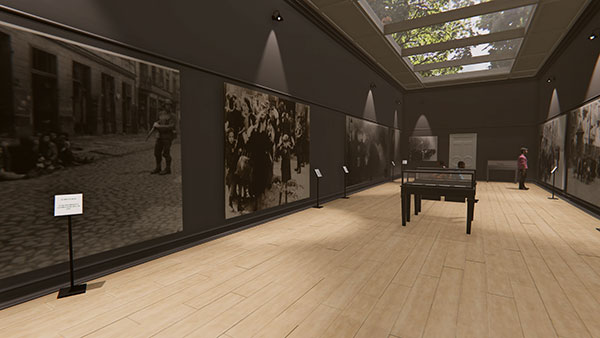 © Paul Tennent/University of Nottingham
© Paul Tennent/University of Nottingham
A new Holocaust perspective
Eye as Witness is a unique public event that has been produced as a result of research carried out by historians, computer scientists, education experts and museum professionals to transform the use of images in understanding and commemorating the Nazi regime and the Holocaust. This AHRC-funded project is called ‘Photography as Political Practice in National Socialism’.
Visitors to the unusual Mixed Reality Experience will enter a virtual Holocaust exhibition filled with Nazi propaganda photos of Holocaust victims. Using state-of-the-art virtual reality computer simulation technology and techniques they will be able to ‘walk into’ a photograph to see the propaganda photographer in the act of taking the picture. They can explore the space to consider the context of the image and discover what was kept out of frame. The VR allows people to view snapshots of this traumatic period in modern history in a private, personal and visceral way.
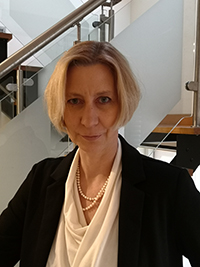 Professor Maiken Umbach
Professor Maiken Umbach
Leading the work, Professor Maiken Umbach from the University of Nottingham’s Department of History said: “The urgency of taking a fresh look at the darkest moment of human history cannot be underestimated. We have relied too much on Nazi propaganda photos to visualise the horrors of the Holocaust. Focusing on the photos and testimonies of victims helps us understand issues that are sadly becoming increasingly pressing in the modern world, such as Anti-Semitism, racism, fake news, and prejudice.”
 © Paul Tennent/University of Nottingham
© Paul Tennent/University of Nottingham
There are many examples of VR reconstructions of historical settings and events. The VR experience of the Eye as Witness distinguishes itself through its use of transition. The visitor is not just placed in a reconstruction, they are first invited to examine the original image, presented in a modern context, but within the VR environment, then literally ‘walk through’ that image to the reconstruction. This keeps the relationship between the source material and the reconstruction incredibly close. It’s not just a reconstruction of a historical scene, it’s a reconstruction of THAT historical scene, as preserved in time in a single frame. Having explored the reconstruction, visitors can return to the virtual gallery and look out the window, where they will find that the VR gallery is situated on the same corner of the same streets where the exhibition took place, adding an additional layer to a visitor’s consideration of the image.
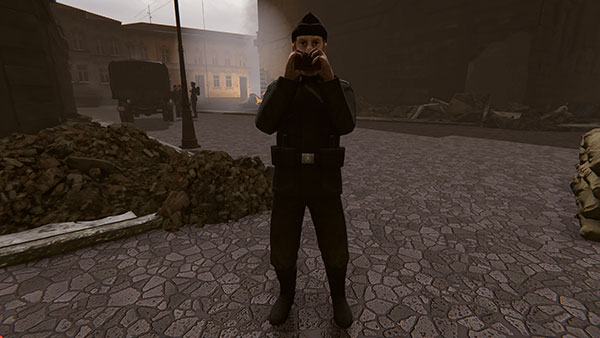 © Paul Tennent/University of Nottingham
© Paul Tennent/University of Nottingham
This moment of transition is further enhanced by the inclusion of a physical barrier. A visitor doesn’t just walk through nothing – they must push through a ‘real’ curtain on which the image is projected, so as a spectator experience, people are seen to be doing just what they appear to be – disappearing into an image of the past. The experience uses state of the art wireless ambulatory virtual reality, allowing multiple visitors to simultaneously explore the experience, and uses eye tracking to help us learn exactly how users interact with and come to understand the space. The same eye tracking allows us to use the cutting-edge technique of foveated rendering, where the computer’s graphics capabilities are focused on what the user is looking at and increasing the quality of that part of a frame.
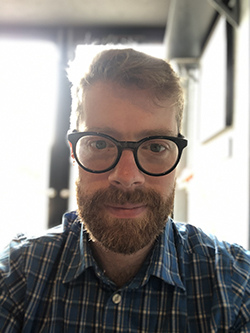 Paul Tennent, Mixed Reality Lab, University of Nottingham
Paul Tennent, Mixed Reality Lab, University of Nottingham
Assistant Professor Paul Tennent from the Mixed Reality Lab in the university’s School of Computer Science said: “The eye as witness is an exercise in technical and interactional creativity. The challenging context helps us to ask questions as researchers about the nature and ethics of reconstructing sensitive scenes. VR technology gives us a powerful tool to deliver these experiences in a deeply immersive and embodied way, but we have a responsibility to apply this with care. Everybody in that photograph was a real person with emotions and a story to tell. It is not our place to embellish their story, but to tell it as well as we can with the tools we have.”
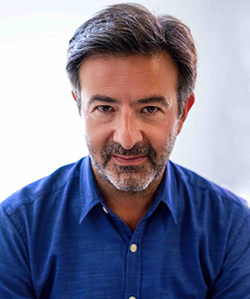 Marc Cave, CEO, National Holocaust Centre and Museum © Forever Holdings
Marc Cave, CEO, National Holocaust Centre and Museum © Forever Holdings
Marc Cave, CEO of the National Holocaust Centre, said: “Whilst the Eye As Witness is an excitingly creative use of technology to reconsider the past, its purpose is chillingly contemporary. When you see an image or video posted on Twitter or Facebook today - of a victim of war or member of a particular minority group - ask yourself who recorded it and why? If pictures are worth a thousand words, then fake news is 1,000 times more sinister in photographic form. As we approach Holocaust Memorial Day 2020 and the 75th anniversary since the Auschwitz and Bergen-Belsen death camps were liberated, this exhibition invites critical thinking. It asks you to understand the visual cunning of the Nazis and how it helped permeate and legitimise anti-Jewish hate — and to think critically about the same propaganda techniques being used on social media today by the Hard Left and the Hard Right alike”.
Beyond the VR headset
The exhibition includes photos that are rarely seen today – secret photos taken by Jewish people and members of the anti-Nazi resistance, who, at great risk to themselves, used the camera to record the story as they saw it. Although these images would in no way change their fate, nor give them power over their situation, these photographs did give victims a degree of control over the way in which their horrific experiences were witnessed to future generations. The visual testimony and a rare example of a written note from the camps is combined with the words of survivors speaking to us today, through an interactive recording technology known as the Forever Project.
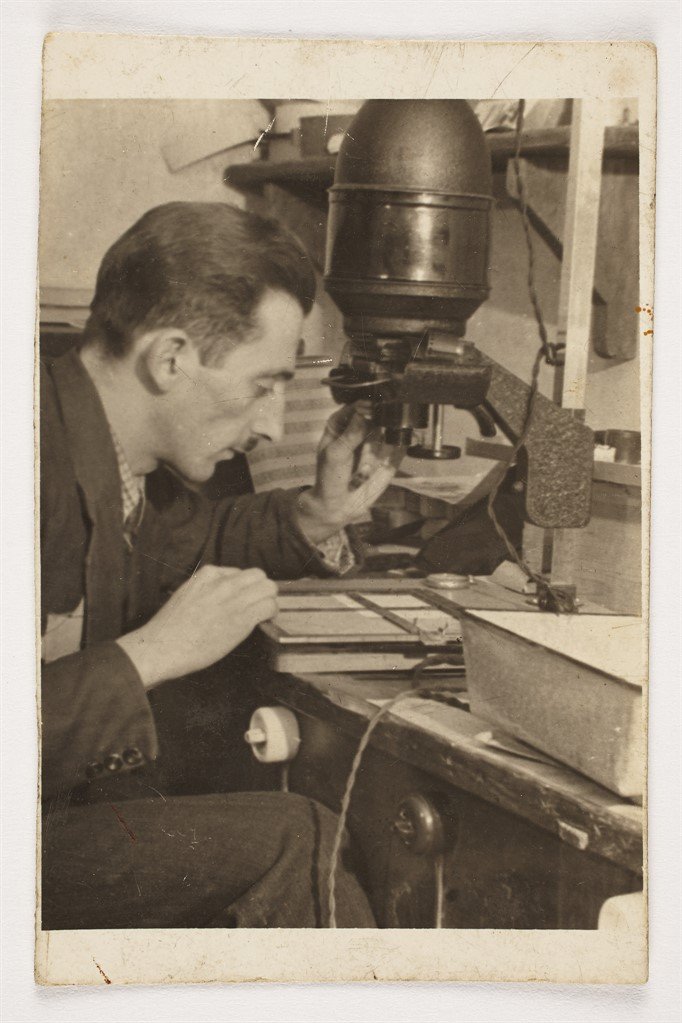 © Mendel Grossman: In the Łódź Ghetto the Jewish photographers Mendel Grossman and Henryk Ross had access to cameras, film material and a darkroom as part as their work for the ‘Judenrat’, the Jewish Ghetto administration. This gave them the opportunity to take secret images of life in the ghetto, capturing their perspective of events, independent from their official duties and in contrast to the official propaganda photos.
© Mendel Grossman: In the Łódź Ghetto the Jewish photographers Mendel Grossman and Henryk Ross had access to cameras, film material and a darkroom as part as their work for the ‘Judenrat’, the Jewish Ghetto administration. This gave them the opportunity to take secret images of life in the ghetto, capturing their perspective of events, independent from their official duties and in contrast to the official propaganda photos.
Visitors also encounter an artwork created by award-winning international artist Lina Selander. Lina has created an intimate space: an old table, some apples, a mirror. In the mirror, we observe a moving collage of photos by victims and perpetrators, as well as empty album pages, prompting us to reflect on the gaps in our understanding, and in our memory. Lina said:
"When I set out to create this artwork, I knew there were two things it could not be: not the voice of a witness, not the pedagogic voice of a museum. My work is a reflection. Images created by victims and survivors of the Holocaust appear in a mirror. But they are never fully visible: we see reflected fragments. In ancient myth, the goddess Athena gives Perseus a mirror-shield, through which the Gorgon’s face is only seen from an angle. Seeing the whole face will turn you into stone.
“This exhibition shows photos by those who have seen the Gorgon’s face. The Sonderkommando photos of Auschwitz were taken from inside a gas chamber. The photographer hid in the absolute darkness. The word camera comes from camera obscura, which means dark chamber. These images reach us from absolute darkness. They remain there; we can only contemplate their reflections. But looking away will turn the world into stone."
Finally, the exhibition invites us to contemplate lessons for today. Shocking images of victims of violence and those fleeing from it may alert us to many contemporary global injustices. But how much do they tell us about the perspective of the victims? Do they allow us to see real people, or do they obscure the very situations they claim to document? Visitors are invited to make their own decisions and record their responses to such photos on an interactive screen.
The exhibition will be touring a number of venues from 13th January 2020 – 24th March 2021 including the Imperial War Museum North, Salford; the Bradford Peace Museum; South Hampstead Synagogue, London; The National Memorial Arboretum, Staffordshire and Lakeside Arts Centre, Nottingham.
Kitty Hart-Moxon, Rudi Oppenheimer and Mala Tribich are Holocaust survivors who were recorded for the Forever Project. Their testimonies will be accessible in the exhibition.
© Bright White Ltd ©The National Holocaust Centre and Museum
Story credits
For more information please contact Professor Maiken Umbach, Department of History, University of Nottingham via email maiken.umbach@nottingham.ac.uk or Emma Rayner, Media Relations Manager for the Faculty of Arts on +44 (0)115 951 5793 or email emma.rayner@nottingham.ac.uk or Rachel Silver PR Consultant for NHCM, email rachel@propheticcowboy.com
Notes to editors:
About the University of Nottingham
Ranked 97 in the world and 17th in the UK by the QS World University Rankings, the University of Nottingham is a founding member of Russell Group of research-intensive universities. Studying at the University of Nottingham is a life-changing experience, and we pride ourselves on unlocking the potential of our students. We have a pioneering spirit, expressed in the vision of our founder Sir Jesse Boot, which has seen us lead the way in establishing campuses in China and Malaysia - part of a globally connected network of education, research and industrial engagement.
Nottingham was crowned Sports University of the Year by The Times and Sunday Times Good University Guide 2024 – the third time it has been given the honour since 2018 – and by the Daily Mail University Guide 2024.
The university is among the best universities in the UK for the strength of our research, positioned seventh for research power in the UK according to REF 2021. The birthplace of discoveries such as MRI and ibuprofen, our innovations transform lives and tackle global problems such as sustainable food supplies, ending modern slavery, developing greener transport, and reducing reliance on fossil fuels.
The university is a major employer and industry partner - locally and globally - and our graduates are the third most targeted by the UK's top employers, according to The Graduate Market in 2024 report by High Fliers Research.
We lead the Universities for Nottingham initiative, in partnership with Nottingham Trent University, a pioneering collaboration between the city’s two world-class institutions to improve levels of prosperity, opportunity, sustainability, health and wellbeing for residents in the city and region we are proud to call home.
More news…